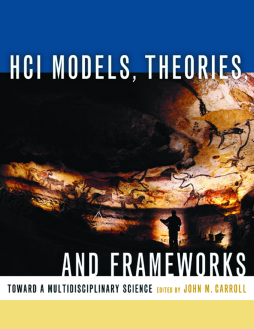
Additional Information
Book Details
Abstract
HCI Models, Theories, and Frameworks provides a thorough pedagological survey of the science of Human-Computer Interaction (HCI). HCI spans many disciplines and professions, including anthropology, cognitive psychology, computer graphics, graphical design, human factors engineering, interaction design, sociology, and software engineering. While many books and courses now address HCI technology and application areas, none has addressed HCI’s multidisciplinary foundations with much scope or depth. This text fills a huge void in the university education and training of HCI students as well as in the lifelong learning and professional development of HCI practitioners. Contributors are leading researchers in the field of HCI. If you teach a second course in HCI, you should consider this book.
This book provides a comprehensive understanding of the HCI concepts and methods in use today, presenting enough comparative detail to make primary sources more accessible. Chapters are formatted to facilitate comparisons among the various HCI models. Each chapter focuses on a different level of scientific analysis or approach, but all in an identical format, facilitating comparison and contrast of the various HCI models. Each approach is described in terms of its roots, motivation, and type of HCI problems it typically addresses. The approach is then compared with its nearest neighbors, illustrated in a paradigmatic application, and analyzed in terms of its future.
This book is essential reading for professionals, educators, and students in HCI who want to gain a better understanding of the theoretical bases of HCI, and who will make use of a good background, refresher, reference to the field and/or index to the literature.
- Contributors are leading researchers in the field of Human-Comptuter Interaction
- Fills a major gap in current literature about the rich scientific foundations of HCI
- Provides a thorough pedogological survey of the science of HCI
"Not since Card, Moran, and Newell's Psychology of Human Computer Interaction in 1983 has so much been brought together to advance the science of HCI. This book is a must-read for researchers and Ph. D. students.
I am very impressed with the undertaking of this book and with its results. We have many models and theories in HCI, and this book collects them and encourages people to think about them together. I'm sure good things will come from those who digest this all."
--Judith Olson, University of Michigan
"Only with slowly evolving frameworks such as these can we understand and guide the advances in technology and its uses that lie ahead. This landmark collection will be of lasting value."
--Jonathan Grudin, Microsoft Research
"Computing and information technologies are providing profound advances for individuals and society. We have gained new insights from perceiving dynamic visualizations; enhanced our thinking by manipulating flexible representations; increased our knowledge through global search technologies; discovered new modes of communication and collaboration through networked technologies; formed new communities and relationships from near-universal access to the Web; developed new methods of buying and selling; and so on.
The phenomena underlying the relation between people and technology are complex and varied. Understanding these phenomena is a real challenge, especially given that they span perceptual, cognitive, social, organizational, commercial, and cultural factors.
Practitioners in HCI disciplines (interaction designers, information architects, usability testers, ethnographic field investigators, etc.) offer skills, methods, and practices to design and evaluate these technologies. Researchers in HCI provide innovations and empirical groundings, as well as theoretical perspectives, which are critical for a robust field. But the theoretical work is scattered across many sources, and practitioners are largely unaware of the range of theoretical work that has been done.
This volume is a valuable collection of diverse theoretical perspectives by some of the most articulate advocates in the field of Human-Computer Interaction. It is a unique resource for grasping the broad landscape of theoretical thinking that frames HCI. HCI practitioners should study it to deepen their understanding of the phenomena they are trying to influence. And HCI researchers should study it for inspiration to broaden and strengthen the theoretical foundations of HCI."
--Tom Moran, IBM Almaden Research Center
